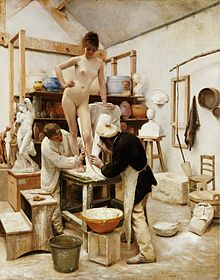Body impression
As Lifecasting or Lebendabformung refers to the shape of loss of a living person or its parts. The death mask , on the other hand, represents a separate area.
Body impressions have been documented on the basis of artefacts since ancient times . In modern times, since the winning Renaissance the impressions of people living in plaster increasingly important as models for castings (for example in bronze in lost wax ) and for study purposes. Since the 19th century, the technology has also been used to manufacture mannequins .
In 20th century art, especially in the 1960s, sculptors used pop art for installations . The works range from pure impression to from the acquired forms processed sculptures and statues , as for example by artists from the United States as Edward Kienholz and Duane Hanson made or by the German artist Harry Kramer in the 1970s under the title panopticon designed were. The materials of the figurative representations, which were created after body molds in plaster of paris, were clay , plaster of paris and paper , or Ulla Horky's mummy sculptures made of glue, paint and tissue paper, but also metals , plastic laminates and silicone were used.
literature
- Lexicon of Art . Volume 1, 1981; P. 5 Keyword cast
- Hans H. Hofstätter (ed.): History of art and artistic techniques . Frankfurt / M., Berlin 1968; Volume 5, p. 103 ff.
